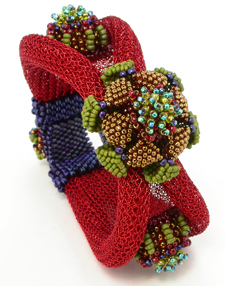|
Jacobean embroidery
is one of the earliest forms of surface stitching. Usually
worked on linen (terrra firma or base) and using 2-ply wool
yarn, this style of crewelwork was influenced by the exotic
flora and fauna found on imported Indian Chintzes that were
brought into Europe in the 1600’s. Unlike other styles,
Jacobean embroidery utilized the open space as well as the
embroidered space. From fanciful fruits & flowers, exotic
animals & birds to insects and the tree of life, multiple
stitches were used to create colorful, scrolling, free style
patterns.
The pattern would
have been “pricked & pounced”, a way to place small dots to
trace the outlines of what was to be stitched. The linen
would have been stretched and placed in a frame.
This embroidery style
flourished in the reign of King James 1 of England in the
first quarter of the 17th century. Popular items were men’s
waistcoats; women’s stomachers, bodices, petticoats and
pockets; and bed curtains, that were pulled on rods around
the bed to ward of the cold.
Jacobean Floral
Bracelet evokes the floral style of early Jacobean
embroidery but with a three-dimensional contemporary take on
traditional techniques. A central artichoke flower made of
Peyote stitch (flat, flat circular and tubular) ties a
coiled tube of metal mesh together in the middle. Nestled
into the rolls of mesh, two other fanciful botanical shapes
fill space, as the mesh works its way to the closure. The
closure encases the ends of the rolled mesh in a beautiful
set of cones embellished with an exotic shape hiding a snap
connection. |

